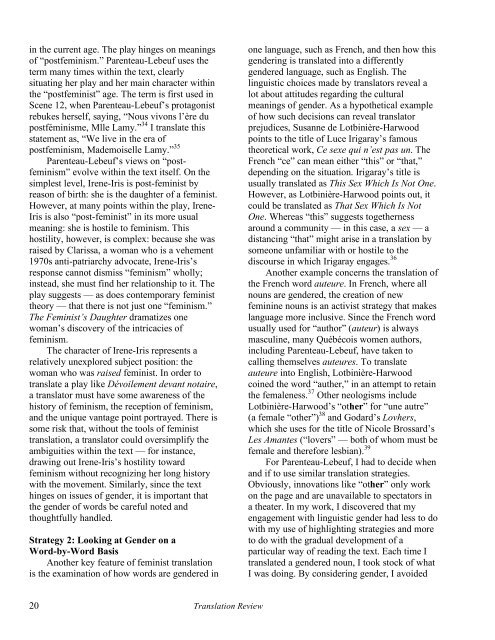Translation Review - The University of Texas at Dallas
Translation Review - The University of Texas at Dallas
Translation Review - The University of Texas at Dallas
You also want an ePaper? Increase the reach of your titles
YUMPU automatically turns print PDFs into web optimized ePapers that Google loves.
in the current age. <strong>The</strong> play hinges on meanings<br />
<strong>of</strong> “postfeminism.” Parenteau-Lebeuf uses the<br />
term many times within the text, clearly<br />
situ<strong>at</strong>ing her play and her main character within<br />
the “postfeminist” age. <strong>The</strong> term is first used in<br />
Scene 12, when Parenteau-Lebeuf’s protagonist<br />
rebukes herself, saying, “Nous vivons l’ère du<br />
postféminisme, Mlle Lamy.” 34 I transl<strong>at</strong>e this<br />
st<strong>at</strong>ement as, “We live in the era <strong>of</strong><br />
postfeminism, Mademoiselle Lamy.” 35<br />
Parenteau-Lebeuf’s views on “postfeminism”<br />
evolve within the text itself. On the<br />
simplest level, Irene-Iris is post-feminist by<br />
reason <strong>of</strong> birth: she is the daughter <strong>of</strong> a feminist.<br />
However, <strong>at</strong> many points within the play, Irene-<br />
Iris is also “post-feminist” in its more usual<br />
meaning: she is hostile to feminism. This<br />
hostility, however, is complex: because she was<br />
raised by Clarissa, a woman who is a vehement<br />
1970s anti-p<strong>at</strong>riarchy advoc<strong>at</strong>e, Irene-Iris’s<br />
response cannot dismiss “feminism” wholly;<br />
instead, she must find her rel<strong>at</strong>ionship to it. <strong>The</strong><br />
play suggests — as does contemporary feminist<br />
theory — th<strong>at</strong> there is not just one “feminism.”<br />
<strong>The</strong> Feminist’s Daughter dram<strong>at</strong>izes one<br />
woman’s discovery <strong>of</strong> the intricacies <strong>of</strong><br />
feminism.<br />
<strong>The</strong> character <strong>of</strong> Irene-Iris represents a<br />
rel<strong>at</strong>ively unexplored subject position: the<br />
woman who was raised feminist. In order to<br />
transl<strong>at</strong>e a play like Dévoilement devant notaire,<br />
a transl<strong>at</strong>or must have some awareness <strong>of</strong> the<br />
history <strong>of</strong> feminism, the reception <strong>of</strong> feminism,<br />
and the unique vantage point portrayed. <strong>The</strong>re is<br />
some risk th<strong>at</strong>, without the tools <strong>of</strong> feminist<br />
transl<strong>at</strong>ion, a transl<strong>at</strong>or could oversimplify the<br />
ambiguities within the text — for instance,<br />
drawing out Irene-Iris’s hostility toward<br />
feminism without recognizing her long history<br />
with the movement. Similarly, since the text<br />
hinges on issues <strong>of</strong> gender, it is important th<strong>at</strong><br />
the gender <strong>of</strong> words be careful noted and<br />
thoughtfully handled.<br />
Str<strong>at</strong>egy 2: Looking <strong>at</strong> Gender on a<br />
Word-by-Word Basis<br />
Another key fe<strong>at</strong>ure <strong>of</strong> feminist transl<strong>at</strong>ion<br />
is the examin<strong>at</strong>ion <strong>of</strong> how words are gendered in<br />
one language, such as French, and then how this<br />
gendering is transl<strong>at</strong>ed into a differently<br />
gendered language, such as English. <strong>The</strong><br />
linguistic choices made by transl<strong>at</strong>ors reveal a<br />
lot about <strong>at</strong>titudes regarding the cultural<br />
meanings <strong>of</strong> gender. As a hypothetical example<br />
<strong>of</strong> how such decisions can reveal transl<strong>at</strong>or<br />
prejudices, Susanne de Lotbinière-Harwood<br />
points to the title <strong>of</strong> Luce Irigaray’s famous<br />
theoretical work, Ce sexe qui n’est pas un. <strong>The</strong><br />
French “ce” can mean either “this” or “th<strong>at</strong>,”<br />
depending on the situ<strong>at</strong>ion. Irigaray’s title is<br />
usually transl<strong>at</strong>ed as This Sex Which Is Not One.<br />
However, as Lotbinière-Harwood points out, it<br />
could be transl<strong>at</strong>ed as Th<strong>at</strong> Sex Which Is Not<br />
One. Whereas “this” suggests togetherness<br />
around a community — in this case, a sex — a<br />
distancing “th<strong>at</strong>” might arise in a transl<strong>at</strong>ion by<br />
someone unfamiliar with or hostile to the<br />
discourse in which Irigaray engages. 36<br />
Another example concerns the transl<strong>at</strong>ion <strong>of</strong><br />
the French word auteure. In French, where all<br />
nouns are gendered, the cre<strong>at</strong>ion <strong>of</strong> new<br />
feminine nouns is an activist str<strong>at</strong>egy th<strong>at</strong> makes<br />
language more inclusive. Since the French word<br />
usually used for “author” (auteur) is always<br />
masculine, many Québécois women authors,<br />
including Parenteau-Lebeuf, have taken to<br />
calling themselves auteures. To transl<strong>at</strong>e<br />
auteure into English, Lotbinière-Harwood<br />
coined the word “auther,” in an <strong>at</strong>tempt to retain<br />
the femaleness. 37 Other neologisms include<br />
Lotbinière-Harwood’s “other” for “une autre”<br />
(a female “other”) 38 and Godard’s Lovhers,<br />
which she uses for the title <strong>of</strong> Nicole Brossard’s<br />
Les Amantes (“lovers” — both <strong>of</strong> whom must be<br />
female and therefore lesbian). 39<br />
For Parenteau-Lebeuf, I had to decide when<br />
and if to use similar transl<strong>at</strong>ion str<strong>at</strong>egies.<br />
Obviously, innov<strong>at</strong>ions like “other” only work<br />
on the page and are unavailable to spect<strong>at</strong>ors in<br />
a the<strong>at</strong>er. In my work, I discovered th<strong>at</strong> my<br />
engagement with linguistic gender had less to do<br />
with my use <strong>of</strong> highlighting str<strong>at</strong>egies and more<br />
to do with the gradual development <strong>of</strong> a<br />
particular way <strong>of</strong> reading the text. Each time I<br />
transl<strong>at</strong>ed a gendered noun, I took stock <strong>of</strong> wh<strong>at</strong><br />
I was doing. By considering gender, I avoided<br />
20 <strong>Transl<strong>at</strong>ion</strong> <strong>Review</strong>

















